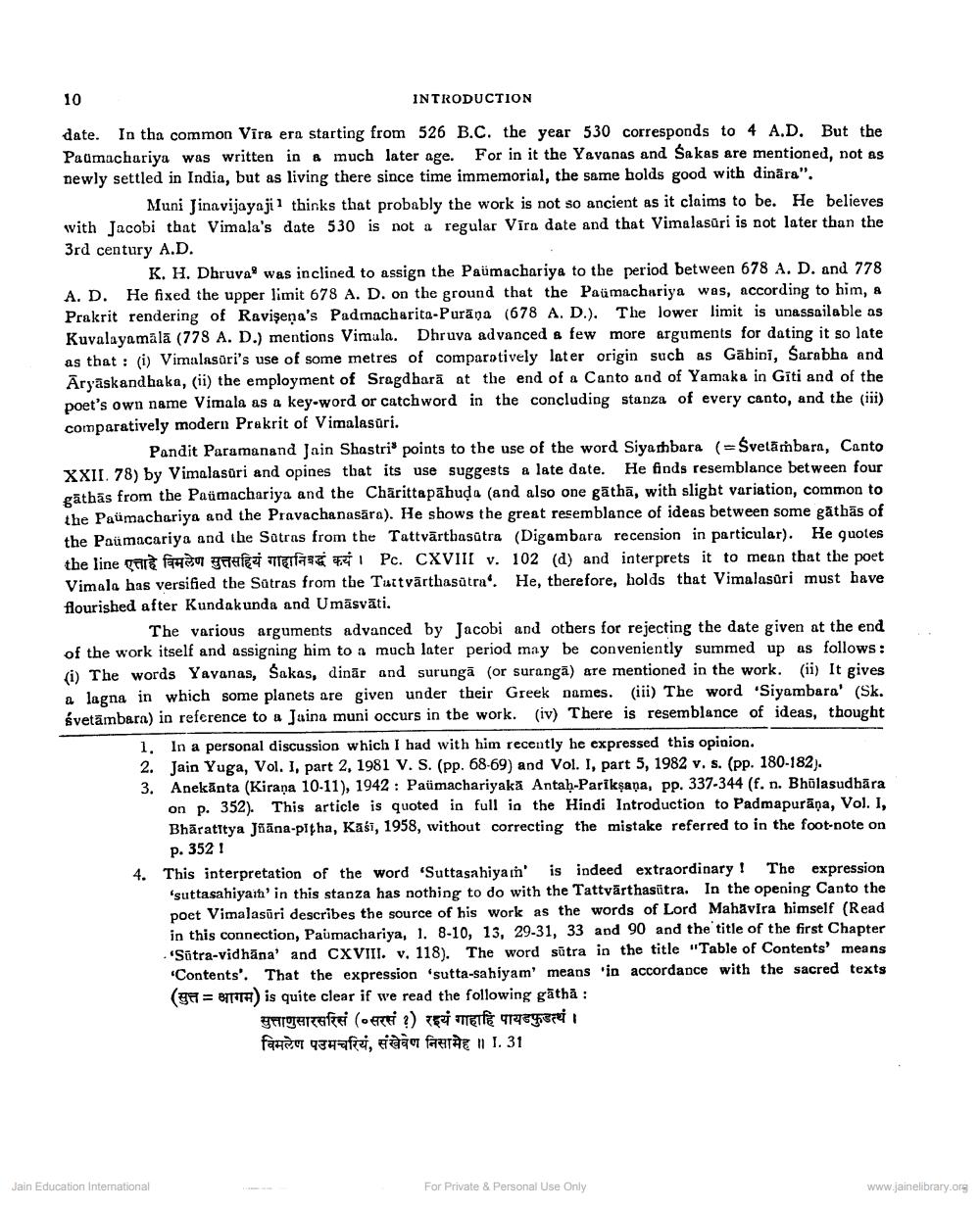________________
10
INTRODUCTION
date. In tha common Vira era starting from 526 B.C. the year 530 corresponds to 4 A.D. But the Paumachariya was written in a much later age. For in it the Yavanas and Sakas are mentioned, not as newly settled in India, but as living there since time immemorial, the same holds good with dinara". Muni Jinavijayaji1 thinks that probably the work is not so ancient as it claims to be. He believes with Jacobi that Vimala's date 530 is not a regular Vira date and that Vimalasūri is not later than the 3rd century A.D.
K. H. Dhruva was inclined to assign the Paümachariya to the period between 678 A. D. and 778 A. D. He fixed the upper limit 678 A. D. on the ground that the Paumachariya was, according to him, a Prakrit rendering of Ravişena's Padmacharita-Purana (678 A. D.). The lower limit is unassailable as Kuvalayamālā (778 A. D.) mentions Vimula. Dhruva advanced a few more arguments for dating it so late as that: (i) Vimalasari's use of some metres of comparatively later origin such as Gabini, Sarabha and Aryaskandhaka, (ii) the employment of Sragdhara at the end of a Canto and of Yamaka in Gīti and of the poet's own name Vimala as a key-word or catchword in the concluding stanza of every canto, and the (iii) comparatively modern Prakrit of Vimalasūri.
Pandit Paramanand Jain Shastri points to the use of the word Siyambara (Svetambara, Canto XXII. 78) by Vimalasari and opines that its use suggests a late date. He finds resemblance between four gāthās from the Paümachariya and the Charittapahuḍa (and also one gatha, with slight variation, common to the Paumachariya and the Pravachanasära). He shows the great resemblance of ideas between some gathās of the Paumacariya and the Satras from the Tattvarthasütra (Digambara recension in particular). He quotes the line are fan gaafở menas Pc. CXVIII v. 102 (d) and interprets it to mean that the poet Vimala has versified the Sütras from the Tattvärthasütra'. He, therefore, holds that Vimalasûri must have flourished after Kundak unda and Umäsvāti.
The various arguments advanced by Jacobi and others for rejecting the date given at the end of the work itself and assigning him to a much later period may be conveniently summed up as follows: (i) The words Yavanas, Šakas, dinar and surunga (or suranga) are mentioned in the work. (ii) It gives a lagna in which some planets are given under their Greek names. (iii) The word 'Siyambara' (Sk. śvetämbara) in reference to a Jaina muni occurs in the work. (iv) There is resemblance of ideas, thought
1. In a personal discussion which I had with him recently he expressed this opinion. 2. Jain Yuga, Vol. I, part 2, 1981 V. S. (pp. 68-69) and Vol. I, part 5, 1982 v. s. (pp. 180-182).
3. Anekanta (Kirana 10-11), 1942: Paümachariyaka Antaḥ-Parikṣaṇa, pp. 337-344 (f. n. Bhulasudhāra on p. 352). This article is quoted in full in the Hindi Introduction to Padmapurāṇa, Vol. I, Bharatiya Jana-pitha, Kasi, 1958, without correcting the mistake referred to in the foot-note on p. 352 !
4. This interpretation of the word 'Suttasahiyam' is indeed extraordinary! The expression 'suttasahiyam' in this stanza has nothing to do with the Tattvärthasütra. In the opening Canto the poet Vimalasuri describes the source of his work as the words of Lord Mahavira himself (Read in this connection, Paumachariya, 1. 8-10, 13, 29-31, 33 and 90 and the title of the first Chapter 'Sutra-vidhana' and CXVIII. v. 118). The word sutra in the title "Table of Contents' means 'Contents'. That the expression 'sutta-sahiyam' means 'in accordance with the sacred texts (g) is quite clear if we read the following gathā:
=
gargerzakkei (««evel 1) vezi merit arvegent i विमलेण पउमचरियं संखेवेण निसामेह ॥ 1. 31
Jain Education International
For Private & Personal Use Only
www.jainelibrary.org




